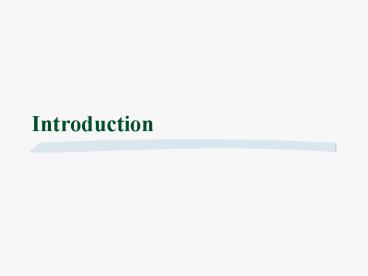Linux - PowerPoint PPT Presentation
1 / 19
Title:
Linux
Description:
Linux, 1991. by Linus Torvalds (Intel, PowerPC, Sparc, and Alpha) System Components ... you be running other operating systems on the same machine? 15. If so, ... – PowerPoint PPT presentation
Number of Views:29
Avg rating:3.0/5.0
Title: Linux
1
Introduction
2
Unix
UNIX at Bell Labs in 1969 Ken Thompson and Dennis
Ritchie multiuser, multitasking, C/S
AIX HP/UX Solaris
Standardization
POSIX (Portable Operating System
Interface) under the auspices of the IEEE
3
Linux
GNU(GNUs Not UNIX) 1983 by Richard Stallman
FSF(Free Software Foundation)
Completed in August, 1996, when a kernel was
added
System Components
Packaging Distribution
RedHat, Debian, MkLinux(Power Mac), Caldera.
4
Linux System
User program
Library
User mode (disk resident)
Kernel mode (memory resident)
System call interface
File subsystem
Process subsystem scheduler memory mgmt IPC
Buffer cache
Block
Character
Device driver
Hardware controller
5
Advantages of Linux
- Full multitasking
- Virtual memory
- The X Window System
- Built-in networking supportTCP/IP, NFS and NIS
- Shared libraries
- Compatibility with the IEEE POSIX.1 standard
- Nonproprietary source code
- Lower cost than most other UNIX systems and UNIX
clones - GNU software support
6
Installation
7
Be Very Prepared
1. How many hard drives do you have? 2. What size
is each hard drive (2.2GB)? 3. If you have more
than one hard drive, which is the primary one? 4.
How much RAM do you have? 5. If you have a
CD-ROM, what type of interface do you have? If it
is not a SCSI or an IDE CD-ROM, who made it and
what model is it? 6. Do you have a SCSI adapter?
If so, who made it and what model is it? 7. What
type of mouse do you have? 8. How many
buttons? 9. If you have a serial mouse, what COM
port is it connected to? 10. What is the make and
model of your video card? How much video RAM do
you have? 11. What kind of monitor do you have
(make and model)?
8
Be Very Prepared
12. What is the allowable range of horizontal and
vertical refresh rates for your monitor? 13. Will
you be connecting to a network? If so, what will
be the following a. Your IP address? b. Your
netmask? c. Your gateway address? d. Your Domain
Name Servers IP address? e. Your domain name? f.
Your hostname? g. Your type of network card? 14.
Will you be running other operating systems on
the same machine? 15. If so, which ones? OS/2?
Windows 95? Windows NT? 16. Will you be using
LILO?
9
Installing
- With Boot Disk
- Under MS-DOS(CD-ROM is G)
- G
- cd images
- ..\dosutils\rawrite
- Enter disk image source file name BOOT.IMG
- Enter target diskette drive a
- Please insert a formatted diskette into drive A
and press ENTER- - Under Linux
- mount o ro /dev/cdrom /mnt/cdrom
- cd /mnt/cdrom/images
- dd ifboot.img of/dev/fd0 bs1440k
- Without Book Disk
- Under MS-DOS(CD-ROM is G)
- G
- cd dosutils
- autoboot.bat
- With CD-ROM
10
Installing
- Language English or Korean
- Keyboard Generic 101-key, U.S. English, None
- Mouse PS/2, 3 button emulate
- Install Type GNOME Workstation
- Automatic Partitioning Remove data
- Partitions
- Linux swap 128M
- Linux Native(ext2)
- / 10
- /usr 20
- /usr/local 20
- /home 40
- /var 10
- Format
11
Installing
- LILO Configuration
- Network Configuration
- IP Address
- Netmask
- Hostname
- Gateway
- Domain Name Server
- Time Zone
- Account Configuration
- Authentication MD5, shadow
- Packages Group everything
- X Configuration use graphical login
- Start install
12
Red Hat Package Manager
- rpm i packagename.rpg
- rpm u packagename.rpg
- rpm qa
- ftp//ftp.redhat.com/pub/redhat/current/i386/RedHa
t/RPMS/
13
System Startup andShutdown
14
Boot Process
/etc/inittab
process 0
LILO
init process 1
inetd
in.telnetd
login
shell
user process
15
Shutting Down
- shutdown -krhfnc -t secs time warning
message - -k dont really shutdown, only warn.
- -r reboot after shutdown.
- -h halt after shutdown.
- -f do a fast reboot.
- -n do not go through init but go down real
fast. - -c cancel a running shutdown.
- -t secs delay between warning and kill signal.
- the time argument is mandatory! (try now)
- halt
- reboot
16
Apache Server
17
Installation
- ftp//ftp.redhat.com/pub/redhat/current/i386/RedHa
t/RPMS/apache-1.3.9-4.i386.rpm - rpm -i --force apache-1.3.9-4.i386.rpm
- /etc/httpd/conf/
- /etc/rc.d/ system startup scripts
- /home/httpd/ server icons and CGI scripts
- /usr/doc/ and /usr/man/
- /usr/sbin/
18
Start and stop server
- Start
- httpd -d directory -f file -v
- -d directory specify an alternate initial
ServerRoot - -f file specify an alternate ServerConfigFile
- Stop
- ps -ef grep httpd
- kill httpdPID
19
/etc/httpd/conf/httpd.conf
- ServerAdmin webmaster_at_your.domain
- ServerName www.your.domain
- Port 80
- ServerRoot /etc/httpd
- DocumentRoot /home/httpd/html
- UserDir public_html
- DirectoryIndex index.html index.cgi index.shtml
- Alias /icons/ "/home/httpd/icons/"
- ScriptAlias /cgi-bin/ "/home/httpd/cgi-bin/"































